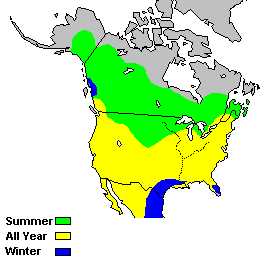
American Kestrel

DESCRIPTION:
Size:
10.5 inches (27 cm) W 23 inches (58 cm)
Abundance:
· Common
Quick Identification:
· Blue-gray wings
· Chestnut back with black spots
· Chestnut tail with broad black tip
· Two black stripes on white face
Identification Tips:
· Short, dark, hooked beak
· Small, long-tailed hawk
· Long, narrow, pointed wings
· Gray crown
· White cheeks
· Two black mustache marks
· Black spot at rear of crown on both sides
· Seen from below, flight feathers are pale with dark barring
· Juveniles and immature females like adult female
Adult male:
· Rust patch on crown
· Rust nape, breast, back and tail
· Rust tail has a broad black subterminal band and a narrow white terminal band
· Pale belly
· Blue-gray wing coverts
· Dark flight feathers with pale subterminal spots creating a "string of pearls"
· Black spots on scapulars, wing coverts and flanks
Adult female:
· Pale buff breast streaked with brown
· Rust-brown nape, back and wing coverts
· Back and wing coverts barred heavily with black
· Rust-brown tail with numerous dark bars of even width and a narrow white
terminal band
Immature male:
· Barred rust-brown back barred heavily with black
· Streaked breast
Similar species:
· Sharp-shinned Hawk is of similar size, but has rounded wings and much
different patterning. Merlin is larger with broader-based wings, lacks rust
tones to back and wing coverts, has a single mustache mark and strongly
checkered underwings.
HABITAT:
Borders of woodlands, farmlands, open fields, pastures with scattered trees,
marshes, suburban areas, grasslands, arid plains, deserts with giant cacti,
wooded canyons, forest openings. Often seen perched on wires along roads in
rural areas. Hunts on the wing, often hovering. Often pumps tail up and down
upon landing. Smallest falcon. Common.
NESTING & FEEDING:
BREEDING: Open or partly open habitats with scattered trees, also cultivated and
urban areas. 1 brood, 2 in s and when small mammal prey very abundant. Mating
system is monogamous.
DISPLAYS: Male flies rapidly in wide circles above perch, bends quivering
wingtips down, calls, occasionally joined by female before realighting on perch.
Pair bow, female constantly calling. Desert populations incorporate courtship
feeding.
NEST: Little, if any, nesting material. 12 to 80 feet high in trees or on cliff.
EGGS: 4-5 White/pinkish-white, marked with browns, occasionally lavender,
occasionally unmarked. 1.4" (35 mm).
CHICK DEVELOPMENT: Female incubates with help from male. Incubation takes 29-31
days. Development is semialtricial (immobile, downy, eyes closed, fed). Young
are able to fly after 30-31 days. Both sexes tend young.
DIET: Also occasionally birds. In desert, young eat only insects for first week,
later also mice. Occasionally aerially forage for insects.
CONSERVATION: Winters s to Panama. Readily uses nest box.
NOTES: Often uses same nest for second brood; male feeds fledglings of first
brood and incubating female. Caches vertebrates, usually in grass clumps.
Competes with other hole-nesters for nest sites. Promiscuous matings
occasionally occur before monogamous bonds form. In winter, individuals defend
territories; females prefer habitat that is open and sparsely vegetated, males
prefer denser vegetation. Formerly known as Sparrow Hawk.
WORLD RANGE:
Falco sparverius AMERICAN KESTREL. Open country, scrub, desert, farms,
towns, pine savanna. Lowlands and mts. to 4400 m from w,c Alaska n to s slopes
of the Brooks Range, nc Yukon, cw,sc Mackenzie and n Alberta e across c,se
Canada to s Newfoundland and Nova Scotia, s to the s U.S., Gulf coast and s
Florida; and to s Baja Calif.; Guadalupe I.; Sonora, Chihuahua, Coahuila and
Nuevo León s in c Mexican highlands to e Michoacan, México and Puebla; s Oaxaca;
Chiapas and s Guatemala to s Honduras and lowland pine savanna of e Honduras and
ne Nicaragua; Bahamas n to Eleuthera; Greater and Lesser Antilles s to
Guadeloupe; from Colombia, Venezuela, Netherlands Antilles e to Margarita I.,
but absent from Bonaire and s Amazonas Prov.; to Trinidad, Tobago, Guyana,
French Guiana and n Brazil in Roraima s, mostly in mts., through Ecuador, Peru,
Bolivia, Chile (incl. Más-á-Tierra in Juan Fernández Islands) and Argentina to
Tierra del Fuego, and e of the Andes (exc. most of Amazonia) over tableland of
c,e Brazil to Paraguay and Uruguay. Northern populations winter from se Alaska
and s Canada s to n South America.
![]()